#jaxa art
Explore tagged Tumblr posts
Text


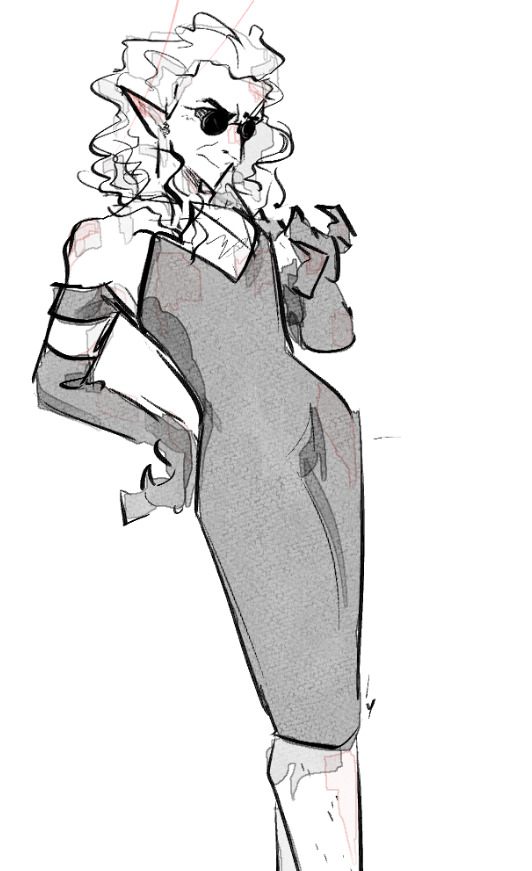
1960s ineffable wives,,,,,,,, plus other doodles from last night
#you cant make me draw crowleys short hair YOUCANT MAKEME#dress crowley was a request isnt he pretty#i DID make a short hair ver of that one but i dont like it#good omens#anthony j crowley#aziraphale#aziracrow#ineffable husbands#ineffable wives#jaxa art#art#we were robbed of 1960s aziracrow
946 notes
·
View notes
Text

Art I made for my amazing space friend 🚀 ✨
#dcmk#detective conan#kaitou kid#kaishin#kuroba kaito#kaito kid#magic kaito#kaito kuroba#traditional art#mk1412#my art#shikishi#shikishi art#hayatsu#Jaxa#watercolors
202 notes
·
View notes
Text

Just a quick little study of Enceladus and Saturn! I might do another piece like this in the future, with a lot more attention to detail; I really love Saturn's moons!
As always, image ID will be in the reblogs. :)
#digital art#artists on tumblr#tolbachik art#space art#my art#space#digital painting#space exploration#moon#moons#cassini#planets#astronomy#nasa#roscosmos#esa#isro#cnsa#jaxa#saturn#enceladus#landscape art#spacescape#landscapes#spacescapes#digital landscape#digital illustration
41 notes
·
View notes
Text

Kill two stones with one bird.
4 notes
·
View notes
Text


OC angst
(Seth & Tye)
#artblr#small artist#artists on tumblr#oc art#original character#original charater art#jaxa ocs#illustration#digital drawing#digital art#digital illustration#seth#tye
2 notes
·
View notes
Text
オモテナシ

「OMOTENASHI」は、JAXA(日本宇宙航空研究開発機構)が開発した小型の月探査機で、2022年にNASAのアルテミス計画の一環として打ち上げられました。この探査機の名前は、日本のおもてなしの心に由来し、小型でありながら高性能な技術を持っています。「OMOTENASHI」は、月面への着陸を目指す最も小型の探査機の一つであり、日本の技術力をアピールするためのプロジェクトでもあります。宇宙探査において、日本の独自のアプローチが注目されましたが、通信に問題が発生し、着陸には至りませんでした。
手抜きイラスト集
1 note
·
View note
Text
This is so cool!

Lunar station concept art from Japan Aerospace Exploration Agency (JAXA), undated.
115 notes
·
View notes
Text


The origin of most meteorites finally revealed
An international team led by three researchers from the CNRS1, the European Southern Observatory (ESO, Europe), and Charles University (Czech Republic) has successfully demonstrated that 70% of all known meteorite falls originate from just three young asteroid families. These families were produced by three recent collisions that occurred in the main asteroid belt 5.8, 7.5, and about 40 million years ago. The team also revealed the sources of other types of meteorites; with this research, the origin of more than 90% of meteorites has now been identified. This discovery is detailed in three papers, a first published on 13 September 2024 in the journal Astronomy and Astrophysics, and two new papers to be published on 16 October 2024 in Nature.
An international team of researchers has shown that 70% of all known meteorite falls originate from three young asteroid families (Karin, Koronis and Massalia) formed by collisions in the main asteroid belt 5.8, 7.5 and about 40 million years ago. In particular, the Massalia family has been identified as the source of 37% of known meteorites.
While more than 70,000 meteorites are known, only 6% had been clearly identified by their composition (achondrites) as coming from the Moon, Mars, or Vesta, one of the largest asteroids in the main belt. The source of the other 94% of meteorites, the majority of which are ordinary chondrites2, had remained unidentified.
Why are these three young families the source of so many meteorites?
This can be explained by the life cycle of asteroid families. Young families are characterised by an abundance of small fragments left over from collisions. This abundance increases the risk of collisions between fragments and, coupled with their high mobility, their escape from the belt, possibly in the direction of Earth. The asteroid families produced by older collisions, on the other hand, are "depleted" sources of meteorites. The abundance of small fragments that once made them up has naturally eroded and finally disappeared after tens of millions of years of successive collisions and their dynamic evolution. Thus, Karin, Koronis and Massalia will inevitably coexist with new sources of meteorites from more recent collisions and eventually give way to them.
A method for tracing the family tree of meteorites and asteroids
This historic discovery was made possible by a telescopic survey of the composition of all the major asteroid families in the main belt, combined with state-of-the-art computer simulations of the collisional and dynamical evolution of these major families. This approach has been extended to all meteorite families, revealing the primary sources of the carbonaceous chondrites and achondrites, which come in addition to those from the Moon, Mars, and Vesta.
Thanks to this research, the origin of more than 90% of meteorites has now been identified. It has also enabled scientists to trace the origin of kilometre-sized asteroids (a size that threatens life on Earth). These objects are the focus of many space missions (NEAR Shoemaker, Hayabusa1, Chang'E 2, Hayabusa2, OSIRIS-Rex, DART, Hera, etc.). In particular, it appears that the asteroids Ryugu and Bennu, recently sampled by the Hayabusa2 (Japanese Aerospace Exploration Agency JAXA) and OSIRIS-REx (NASA) missions and studied in laboratories around the world, particularly in France, are derived from the same parent asteroid as the Polana family.
The origin of the remaining 10 per cent of known meteorites is still unknown. To remedy this, the team plans to continue their research, this time focusing on characterising all young families that were formed less than 50 million years ago.
From the Laboratory of Astrophysics of Marseille (Aix-Marseille Université/CNRS/CNES).
Meteorites consisting of silicates, representing approximately 80% of all known meteorites.
TOP IMAGE: El Médano 128 meteorite, an ordinary chondrite (group L), found in the Atacama desert in 2011 by a team of researchers from the Centre de recherche et d'enseignement des géosciences de l'environnement (CEREGE - Aix-Marseille Université/CNRS/INRAE/IRD) Credit © Jérôme Gattacceca, CNRS, CEREGE
LOWER IMAGE: Polarised transmitted light image of the ordinary chondrite (group H) San Juan 029, found in the Atacama Desert in 2008 by a team of researchers from CEREGE. Image width 3 mm. Credit © Jérôme Gattacceca, CNRS, CEREGE
8 notes
·
View notes
Text
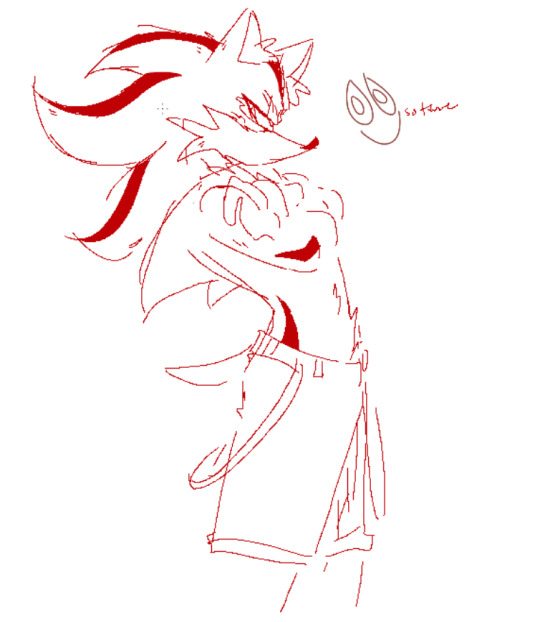





sonic and shadow doodle collection,,, sorta just filler because i'm working on some doodles for an AU i've been thinking about 🐠
#sonadow#sonic the hedgehog#shadow the hedgehog#sth#sonic#sonic fanart#art#sonic prime#i know sonic looks kinda short in the last one#i suck at scaling and much prefer short shadow but shhhhh don't look at it#the way i draw sonic is so inconsistent it drives me INSANEEEE#i know some of these were in my intro post so this is kinda a repost l#jaxa art
220 notes
·
View notes
Text
Character Spotlight: Worf
By Ames
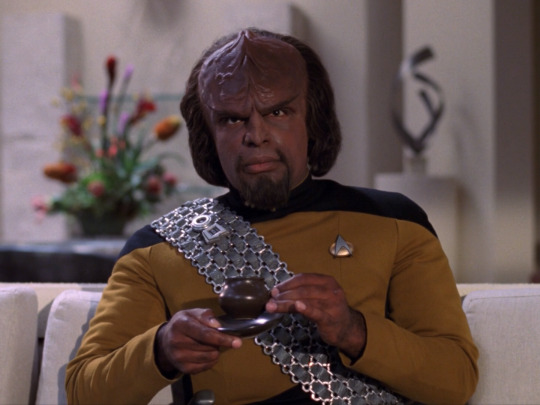
It’s an honorable week here on A Star to Steer Her By because we’re shining our character spotlight on the show’s first Klingon main character, Worf, Son of Mogh! He’s also the first specifically main cast member to span two different series (sorry, O’Brien), so we’ve got glimpses from both The Next Generation and its films and also Deep Space Nine to cover. Worf might get the most time of any character to truly develop, growing from the guy who gets thrown across the room by the baddie of the week into the complex warrior who, for just a moment, wears the robes of the Chancellor of the Klingon High Council. Go Worf!
So put on your baldric, grab your bat’leth, and top off your mug of bloodwine as we give Worf all the honor he deserves (which every so often, isn’t very much, but other times is a lot!). Read on for the commendable battles below and listen to our death yells over on this week’s podcast (fight your way to 55:39). Today is a good day to die.
[Images © CBS/Paramount]
Best moments
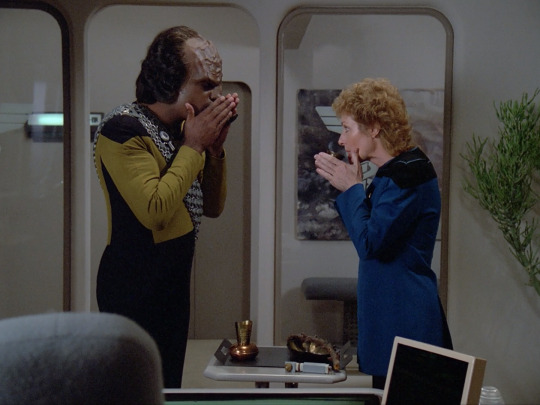
Bloodwine is red / Andorians are blue… While we gave Dr. Pulaski lots of props for whipping up an antidote so she could participate in Worf’s version of a tea party, it’s also just lovely that Worf honors her by performing the ceremony in the first place in “Up the Long Ladder.” Deep down under the head ridges and scowl, Worf is just a poetry-reading, tea-sipping teddy bear and we love it.
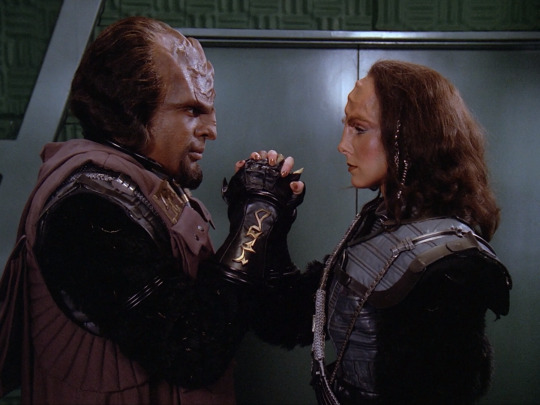
Klingon paper dolls Star Trek characters jump at any opportunity to play dress up, and we get a good instance of that in “The Emissary” when Worf and K’Ehleyr put on their warrior garb to trick a crew of Klingons in cryostasis into thinking they represent the Klingon Empire. As always, this episode gets some extra points for featuring K’Ehleyr, and it turns out Worf’s pretty good at improvisation too.
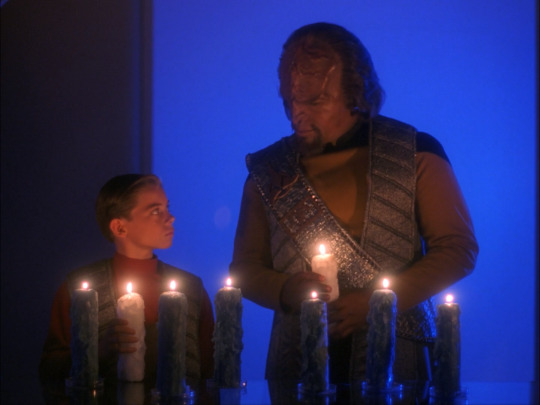
We have bonded and our families are stronger While we’re certainly going to give Worf some shit for how badly he parents his biological son, his connection with Jeremy Aster in “The Bonding” is actually quite beautiful for the both of them. Each an orphan, they are able to form a familial-type relationship together, and it’s really touching when Worf invites Jeremy to join him in the R'uustai that will bond them as brothers.
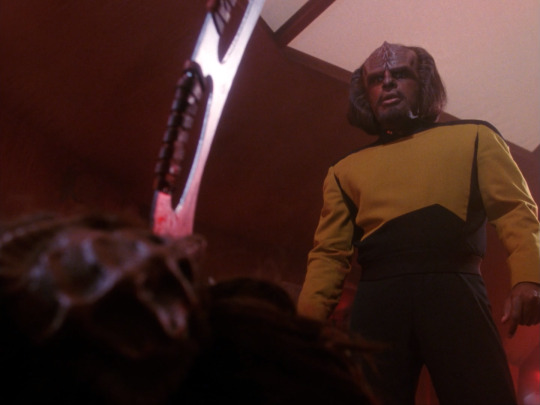
He has claimed the right of vengeance A trend emerged in our Best Worf Moments when they tended to fall into the “killing the fuck out of some jerk who deserves it” category, and the first to really deserve it is Duras in “Reunion.” Duras has been begging to get murdered since we first heard his contemptible name, but when he killed Worf’s mate in cold blood, Worf knew exactly what he had to do with his bat'leth.
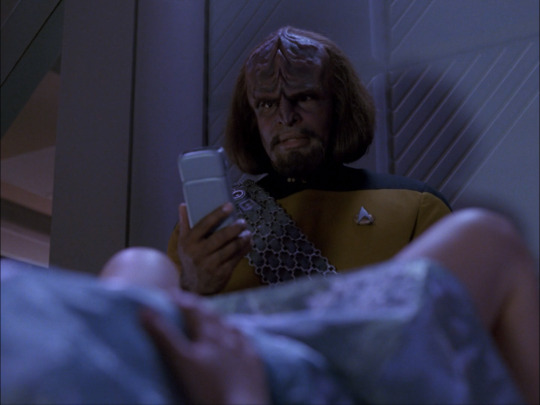
You may now give birth Despite the fact that it resulted in adding a baby to the cast (blech), we have to give some credit to Worf for delivering the O’Brien baby in “Disaster” in a way that only he could. We’d need a whole additional blogpost for all the great Worf one-liners throughout the two series, as Michael Dorn’s delivery is always gold, but “Push, Keiko, push” has got to be pretty high up there.

Doesn’t gik’tal mean to the death? Worf sees so much potential in Sito Jaxa in “Lower Decks” and spends most of the episode arguing on her behalf for a promotion. So when we see Worf testing her with the made-up gik’tal martial arts to teach her to stick up for herself, we can’t help but see in her just what Worf sees. Ya know, until Picard totally gets her killed.

Assimilate this! Sure, it’s a soundbite-y line designed to be marketable in the trailer, but when Worf survives getting his EV suit punctured by tying it off with some Borg bits and then blows up the interplexing beacon in First Contact, it just feels right. Maybe it’s that Michael Dorn can get away with cheesy lines like “Assimilate this!” or maybe we just love watching Borg explode.
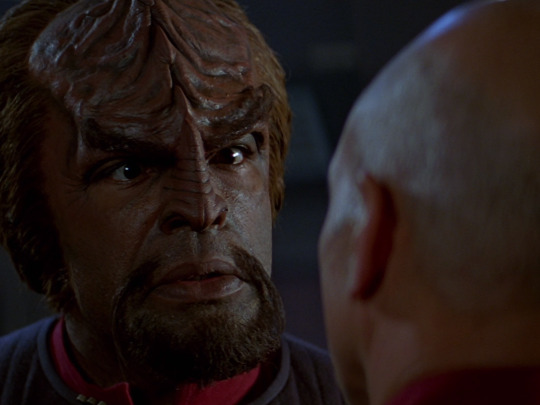
If you were any other man, I would kill you where you stand While the movies are mostly showcases for Picard and Data, First Contact gives some great moments to the other castmembers. Worf’s standoff with Picard is nothing short of chilling. Borg are overrunning the ship and Picard orders Worf and his security team to what is almost certain to be their deaths. Lucky for us, Worf doesn’t actually mutiny, just threatens to a little bit.
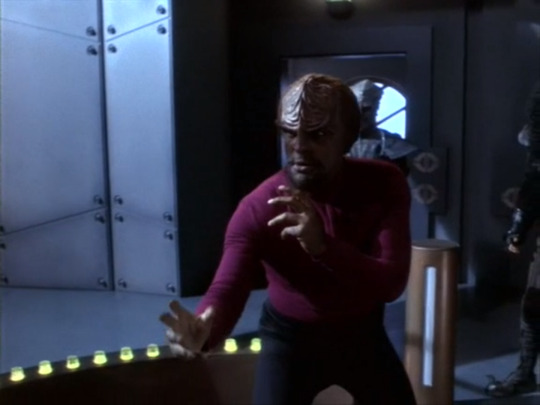
And in this corner… While we spent most of The Next Generation watching Worf getting knocked around as shorthand for “the alien threat is strong,” by Deep Space Nine, we don’t really get that anymore and instead he actually gets to kick some ass! In “By Inferno's Light,” Worf is forced to battle Jem’Hadar after Jem’Hadar in the fighting ring, and he refuses to quit even when he has every right to.

Help me fight again, Worf You’ll see in a second that sometimes when Worf tries to help another Klingon die with honor, things can get complicated, but when Kor asks for help going out in the warrior fashion, Worf is totally a good guy about it. He gets the old legend a place on Martok’s ship in “Once More Unto the Breach” even though it’s not Martok’s favorite thing, but in the end, Sto’Vo’kor gains a new warrior.

Seven down, one to go We still have more “killing the fuck out of some jerk who deserves it” mentions to bring up! What list would be complete without the murder of at least one Weyoun on it? In this case, Worf straight up snaps the neck of Weyoun 7 in “Strange Bedfellows” when he has the opportunity and it is a thing of such beauty that it gains Damar’s respect.

What I have done was for the Empire Finally, our last jerk who needed to get killed the fuck out of is that bastard Gowron in “Tacking into the Wind.” Gowron was going around making terrible decisions, rewriting the history books, and trying to get Martok killed in various ways, and Worf finally has enough and kills him in honorable combat. He gets the cloak of the Chancellor for it but selflessly passes it to Martok, like an absolute boss.
—
Worst moments
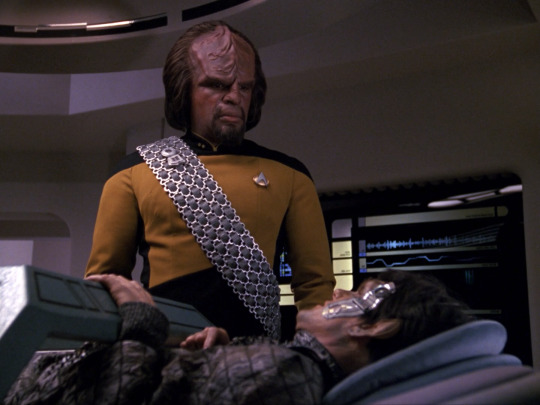
I would rather die than pollute my body with Klingon filth While Geordi is putting racism aside to be able to coexist with his new BFF Bochra in “The Enemy,” Worf takes the opposite path. By refusing to let Crusher give his blood to Patahk, Worf condemns the injured Romulan to death just because of his race. And then the show takes some of the guilt off Worf by having Patahk refuse treatment anyway, leaving Worf’s hands clean, I guess.
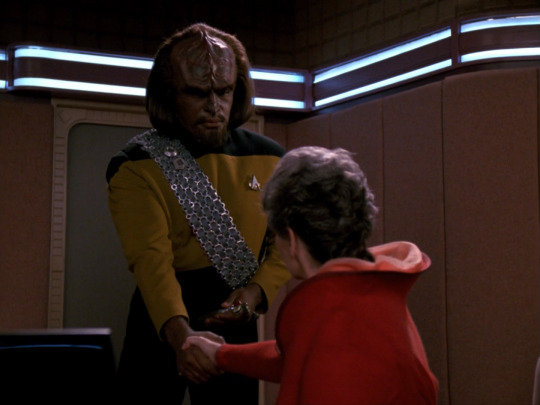
This is not unlike a drumhead trial Worf is also quick to fall in line with Admiral Satie’s Red Scare of a trial against crewman Tarses in “The Drumhead.” He gets so infatuated with dispensing justice that he jumps past “innocent until proven guilty” and determines that Tarses is guilty of treason because he’d lied about his alien heritage, when the two things aren’t even related.

Would you further dishonor our family with your disobedience? It’s a running joke in the Star Trek community that Worf is a terrible father and… well, he is. To his defense, he did have Alexander sprung on him when K’Ehleyr died in “Reunion,” and he did try to pawn the little brat off on the Rozhenkos, but that was a terrible move too. So when we watch how clueless he is trying to parent in “New Ground,” we cringe hard at how Worf just doesn’t get it.
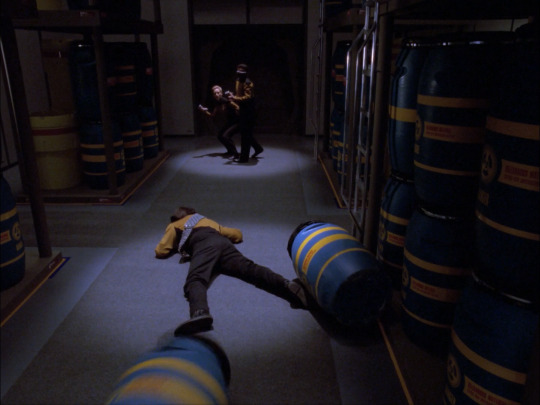
Donkey Kong: 1. Worf: 0. A lot of Worf’s decisions about how to deal with his paraplegia in “Ethics” are complicated and problematic, but the way he ended up in such a state is what we’re really here to roast him on. My dude got bitched by a big blue plastic barrel in the cargo bay, and that is downright dishonorable for a Klingon warrior. Battle, sure. Explosion, fine. Spat with Spot, of course. But not blue barrel!
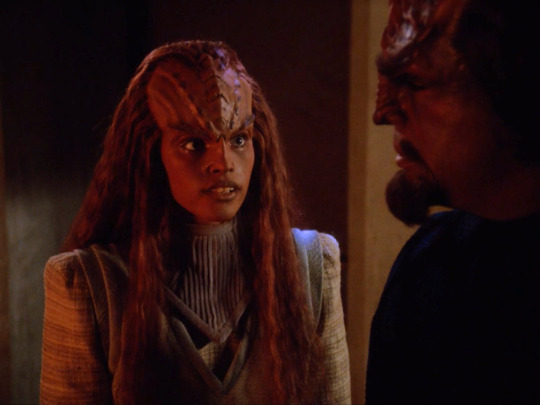
How could your mother mate with a Romulan? Worf’s prejudice against Romulans comes out again in “Birthright” when he learns that Ba’el is half Romulan and he starts spouting racist accusations at her when he’s already seen what kind of a person she is, and even what kind of person her father is. Since his father’s death at Khitomer, it’s a long road for Worf to accept that all Romulans are not that same, and it’s unclear if he ever gets there.

Tell him he is a pretty cat and a good cat All your hosts here at A Star to Steer Her By are ride-or-die cat people, so when Worf refuses to tell Spot he’s a good cat and a pretty cat in “Phantasms” when Data asks him to look after the feline, we take it super personally. Frankly, Data should have looked elsewhere for someone to catsit because what’s supposed to be a humorous moment in the show just makes us angry at Worf. Hiss!
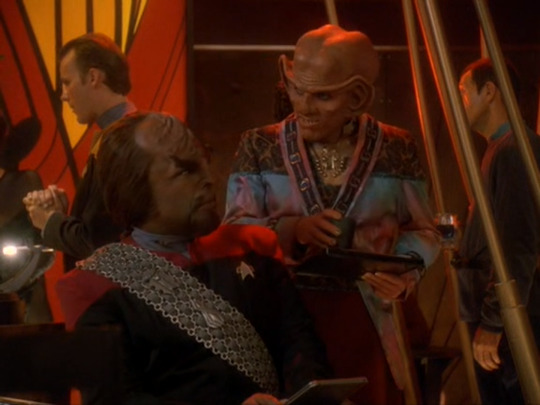
I believe the Ferengi bartender is plotting something By the time Worf joins Deep Space Nine, his racism against Romulans doesn’t come up, but his racism against the Ferengi sure does. Ever since “Hippocratic Oath,” Worf refuses to call Quark by name, instead calling him “The Ferengi bartender.” We joke sometimes on the podcast that the only race it’s okay to be racist against is the Ferengi, but you know what? It’s really not okay.

My life is in your hands Sure, we can argue that Kurn coming to Worf for the Klingon rite of Mauk-to’Vor in “Sons of Mogh” is messed up and puts Worf in a tough position, but Worf manages to pick an even worse outcome for his brother. Instead of killing him and sending Kurn to Sto’Vo’kor with his honor intact, Worf does the least honorable thing and has Bashir wipe Kurn’s memory. Without Kurn’s consent! Eeesh.
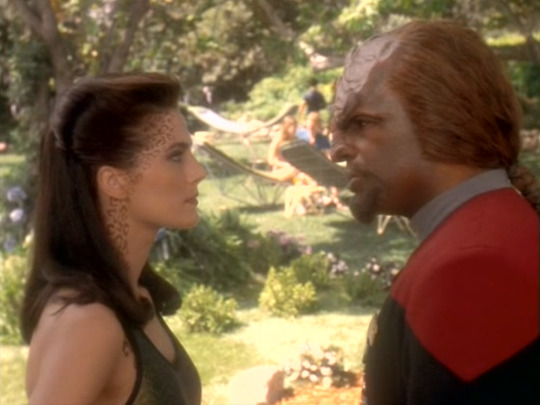
Everything you do reflects on me There were a bunch of times during DS9 that we really thought Jadzia could do better than having Worf as her mate, and “Let He Who Is Without Sin” is the chief offender. Worf starts the episode arguing about Jadzia consorting with other men even though she’s with him now, gets jealous of the Dax’s previous relationships, and generally poopoo’s Jadzia’s streak of individuality like a toxic boyfriend.

Have you accepted Kahless as your lord and savior? And that’s not even the worst thing Worf does in the abysmal episode “Let He Who Is Without Sin.” He spends the rest of their vacation on Risa palling around with the New Essentialists who’ve decided that people enjoying things is bad form, which is just Worf being petty. So when he goes out of his way to help them literally rain on everyone’s parade, it’s super damaging to his character.
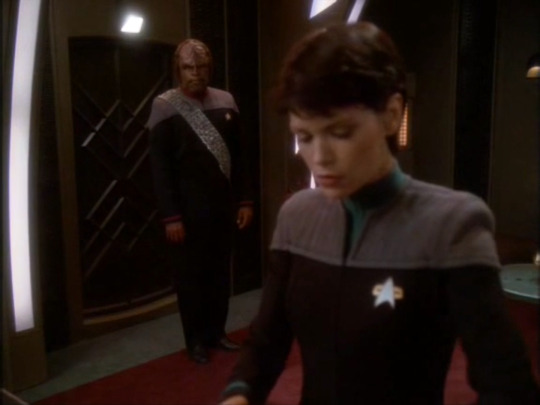
I do not know you, nor do I wish to know you After Jadzia’s death, Worf utterly fails as grieving in a healthy, productive way and instead opts to take it out on Ezri during “Afterimage.” Just because she’s not Jadzia, Worf treats the poor Trill with disdain, ignoring the fact that she too is living through the trauma of being joined to the symbiont. None of this is her fault! Don’t yell at the innocent cupcake!

If it looks like a Dax and it quacks like a Dax… Worf and Jadzia had chemistry like whoa and we were here for it. Worf and Ezri… just don’t. So when they bump uglies in “Penumbra,” we just find it kinda gross and distasteful. My dude, that is not your wife anymore, and she’s in a very vulnerable state having had the Dax symbiont thrust upon her, so it strikes us as kind of problematic that they go to the bone zone (and I don’t mean Worf’s calisthenics program).
—
Qapla’! Now that we’ve got our honor back, take the R'uustai with us and subscribe so that you can see our next batch of character spotlights as we segue smoothly into our crewmates from Deep Space Nine! On the flip side, you can listen along to our dishonorable rewatch of Enterprise over on SoundCloud or wherever you podcast, challenge us to a bat’leth fight on Facebook and Twitter, and join us for some good tea in a nice house.
#star trek#star trek podcast#podcast#worf#the next generation#first contact#deep space nine#up the long ladder#the emissary#the bonding#reunion#disaster#lower decks#by inferno's light#once more unto the breach#strange bedfellows#tacking into the wind#the enemy#the drumhead#new ground#ethics#birthright#phantasms#hippocratic oath#sons of mogh#let he who is without sin#afterimage#penumbra#klingon#michael dorn
7 notes
·
View notes
Text
Welcome to my Blog!
★ Hello! My name is JS. Don't mind me.
★ he/him | 22 | Japanese/English bilingual
★ Fixations: Ace Attorney (specifically AA4), NASA/JAXA, Vocaloid, Mob Psycho 100, Pokemon (esp BW and SV)
★ I'm planning on writing fanfics/ posting doodles on this blog! May not be too active though because I'm also busy working at my dream job :D
★ Feel free to send asks/reply/whatever! I promise I won't bite!
TAGS
★ My Art!
3 notes
·
View notes
Note
Hey! I'm intrigued by the DS9/Voyager crossover! What inspired you to write it? Are there any interesting/fun dynamics between characters you weren't expecting?
I'm also looking at your Wayhaven WIPs, especially the time travel one. Do you perhaps have a snippet from one of them to share? <3
You asked about the DS9/VOY crossover! Like with so many of my longfic ideas, I just really, really like exploring what-ifs, and back in university I was part of the Star Trek Society, which meant my mind way pretty much saturated with Trek. The basic question of "What if Voyager never got taken by the Caretaker?" got stuck in my head and since VOY and DS9 are my two favourite Trek shows, it made sense for Voyager as a state-of-the-art ship to be posted at DS9 to deal with the conflict with the Maquis and later with the Dominion. The whole thing is planned out and the only reason I haven't written it yet was because I misplaced the USB with the first five chapters and only recently found it again. And I need a sensitivity reader to make sure I handle Chakotay better than the original writers did. And I got obsessed with Dragon Age.
There are so many dynamics that make me really excited for this crossover, including but not limited to:
Janeway and Sisko: the two highest-ranking Starfleet officers in the sector, both a bit gung ho, masters of snark, crafty as fuck, and determined to bring down the Maquis, make the ultimate dream team of Federation overachivement and the biggest thorn in the Dominion's side throughout the war. A mutual respect turning into genuine friendship is something I can definitely see happening
Tom, Harry, B'Elanna, O'Brien, Bashir, and Dax: just. The shenanigan potential of these two groups coming together would be off the charts
Worf and B'Elanna: As the only two Klingons in Starfleet with relatable yet completely different upbringings and relationships to Klingon culture, they should and would have some very deep, meaningful conversations about their place in Starfleet. In particular I want Worf to offer mentorship like he did to Sito Jaxa in "Lower Decks"
There are a bunch of other relationships I would tweak as well, e.g. Garak/Bashir and giving Janeway/Chakotay much more of an enemies to lovers vibe. You're making me love this again - I may actually write it after 9 years in limbo XD
And as for my TWC fics... they're all still in the planning stage so far so nothing concrete is written beyond some scribbled notes, but I can reveal that the opening scene in the time travel fic is Nate and Leah waking up to the start of a day off, only for cuddling to be interrupted by Adam. First he tries Nate's phone but Leah flings it across the room 'by accident', but they have to answer when Leah's phone starts ringing too. and then things get serious >:)
Thank you for the questions!
--
Ask me about my WIPs
6 notes
·
View notes
Text

*throw up art at u* Some doodle of Jaxa, an girl version of Jax? *run away*
1 note
·
View note
Text
NASA Soars to New Heights in First 100 Days of Trump Administration - NASA
New Post has been published on https://sunalei.org/news/nasa-soars-to-new-heights-in-first-100-days-of-trump-administration-nasa/
NASA Soars to New Heights in First 100 Days of Trump Administration - NASA

Today is the 100th day of the Trump-Vance Administration after being inaugurated on Jan. 20. In his inaugural address, President Trump laid out a bold and ambitious vision for NASA’s future throughout his second term, saying, “We will pursue our manifest destiny into the stars, launching American astronauts to plant the Stars and Stripes on the planet Mars.” NASA has spent the first 100 days in relentless pursuit of this goal, continually exploring, innovating, and inspiring for the benefit of humanity.
“In just 100 days, under the bold leadership of President Trump and acting Administrator Janet Petro, NASA has continued to further American innovation in space,” said Bethany Stevens, NASA press secretary. “From expediting the return of American astronauts home after an extended stay aboard the state-of-the-art International Space Station, to bringing two new nations on as signatories of the Artemis Accords, to the historic SPHEREx mission launch that takes us one step closer to mapping the secrets of the universe, NASA continues to lead on the world stage. Here at NASA, we’re putting the America First agenda into play amongst the stars, ensuring the United States wins the space race at this critical juncture in time.”
A litany of victories in the first 100 days set the stage for groundbreaking success throughout the remainder of the term. Read more about NASA’s cutting-edge work in this short, yet dynamic, period of time below:
Bringing Astronauts Home Safely, Space Station Milestones
America brought Crew-9 safely home. NASA astronauts Butch Wilmore, Suni Williams, and Nick Hague, along with Roscosmos cosmonaut Aleksandr Gorbunov, returned to Earth after a successful mission aboard the International Space Station, splashing down in the Gulf of America. Their safe return reflects America’s unwavering commitment to the agency’s astronauts and mission success.
A new, American-led mission launched to space. The agency’s Crew-10 mission is currently aboard the space station, with NASA astronauts Anne McClain and Nichole Ayers, joined by international partners from Japan and Russia. NASA continues to demonstrate American leadership and the power of space diplomacy as we maintain a continuous human presence in orbit.
The agency welcomed home NASA astronaut Don Pettit, concluding a seven-month science mission aboard the orbiting laboratory. Pettit landed at 6:20 a.m. Kazakhstan time, April 20 on his 70th birthday, making him NASA’s oldest active astronaut and the third oldest person to reach orbit.
NASA astronaut Jonny Kim launched and arrived safely at the International Space Station, marking the start of his first space mission. Over eight months, he’ll lead groundbreaking research that advances science and improves life on Earth, proving once again that Americans are built to lead in space.
The four members of the agency’s SpaceX Crew-11, NASA astronauts Zena Cardman and Mike Fincke, JAXA (Japan Aerospace Exploration Agency) astronaut Kimiya Yui, and Roscosmos cosmonaut Oleg Platonov were named by NASA. Launching no earlier than July 2025, this mission continues America’s leadership in long-duration human spaceflight while strengthening critical global partnerships.
NASA announced Chris Williams will launch in November 2025 for his first spaceflight. His upcoming mission underscores the pipeline of American talent ready to explore space and expand our presence beyond Earth.
NASA is inviting U.S. industry to propose two new private astronaut missions to the space station in 2026 and 2027 – building toward a future where American companies sustain a continuous human presence in space and advance our national space economy.
NASA and SpaceX launched the 32nd Commercial Resupply Services mission, delivering 6,700 pounds of cargo to the International Space Station. These investments in science and technology continue to strengthen America’s leadership in low Earth orbit. The payload supports cutting-edge research, including:
New maneuvers for free-flying robots
An advanced air quality monitoring system
Two atomic clocks to explore relativity and ultra-precise timekeeping
Sending Humans to Moon, Mars
Teams began hot fire testing the first of three 12-kW Solar Electric Propulsion (SEP) thrusters. These high-efficiency thrusters are a cornerstone of next-generation spaceflight, as they offer greater fuel economy and mission flexibility than traditional chemical propulsion, making them an asset for long-duration missions to the Moon, Mars, and beyond. For Mars in particular, SEP enables three key elements required for success:
Sustained cargo transport
Orbital maneuvering
Transit operations
NASA completed the fourth Entry Descent and Landing technology test in three months, accelerating innovation to achieve precision landings on Mars’ thin atmosphere and rugged terrain.
NASA’s Deep Space Optical Communications experiment aboard Psyche broke new ground, enabling the high-bandwidth connections vital for communications with crewed missions to Mars.
Firefly Aerospace’s Blue Ghost Mission One successfully delivered 10 NASA payloads to the Moon, advancing landing, autonomy, and data collection skills for Mars missions.
Intuitive Machines’ IM-2 mission achieved the southernmost lunar landing, collecting critical data from challenging terrain to inform Mars exploration strategies.
NASA cameras aboard Firefly’s Blue Ghost lander captured unprecedented footage of engine plume-surface interactions, offering vital data for designing safer landings on the Moon and Mars.
The agency’s Stereo Cameras for Lunar Plume-Surface Studies (SCALPSS) 1.1 aboard Blue Ghost collected more than 9,000 images of lunar descent, providing insights on lander impacts and terrain interaction to guide future spacecraft design.
New SCALPSS hardware delivered for Blue Origin’s Blue Mark 1 mission also is enhancing lunar landing models, helping build precision landing systems for the Moon and Mars. The LuGRE (Lunar Global Navigation Satellite System Receiver Experiment) on Blue Ghost acquired Earth navigation signals from the Moon, advancing autonomous positioning systems crucial for lunar and Mars operations.
The Electrodynamic Dust Shield successfully cleared lunar dust, demonstrating a critical technology for protecting equipment on the Moon and Mars.
Astronauts aboard the space station conducted studies to advance understanding of how to keep crews healthy on long-duration Mars missions.
NASA’s Moon to Mars Architecture Workshop gathered industry, academic, and international partners to refine exploration plans and identify collaboration opportunities.
Artemis Milestones
NASA completed stacking the twin solid rocket boosters for Artemis II, the mission that will send American astronauts around the Moon for the first time in more than 50 years. This is a powerful step toward returning our nation to deep space.
At NASA’s Kennedy Space Center in Florida, teams joined the core stage with the solid rocket boosters inside the Vehicle Assembly Building.
Engineers lifted the launch vehicle stage adapter atop the SLS (Space Launch System) core stage, connecting key systems that will soon power NASA’s return to the Moon.
Teams received the Interim Cryogenic Propulsion Stage and moved the SLS core stage into the transfer aisle, clearing another milestone as the agency prepares to fully integrate America’s most powerful rocket.
NASA attached the solar array wings that will help power the Orion spacecraft on its journey around the Moon, laying the groundwork for humanity’s next giant leap.
Technicians installed the protective fairings on Orion’s service module to shield the spacecraft during its intense launch and ascent phase, as NASA prepares to send astronauts farther than any have gone in more than half a century.
The agency’s next-generation mobile launcher continues to take shape, with the sixth of 10 massive modules being installed. This structure will carry future Artemis rockets to the launch pad.
NASA and the Department of Defense teamed up aboard the USS Somerset for Artemis II recovery training, ensuring the agency and its partners are ready to safely retrieve Artemis astronauts after their historic mission around the Moon.
NASA unveiled the Artemis II mission patch. The patch designates the mission as “AII,” signifying not only the second major flight of the Artemis campaign but also an endeavor of discovery that seeks to explore for all and by all.
America First in Space
NASA announced the first major science results from asteroid Bennu, revealing ingredients essential for life, a discovery made possible by U.S. leadership in planetary science through the OSIRIS-REx (Origins, Spectral Interpretation, Resource Identification, and Security-Regolith Explorer) mission. The team found salty brines, 14 of the 20 amino acids used to make proteins, and all five DNA nucleobases, suggesting that the conditions and ingredients for life were widespread in our early solar system. And this is just the beginning – these results were from analysis of only 0.06% of the sample.
NASA was named one of TIME’s Best Companies for Future Leaders, underscoring the agency’s role in cultivating the next generation of American innovators.
NASA awarded contracts to U.S. industry supporting Earth science missions, furthering our understanding of the planet while strengthening America’s industrial base.
As part of the Air Traffic Management-Exploration project, NASA supported Boeing’s test of digital and autonomous taxiing with a Cessna Caravan at Moffett Federal Airfield. The test used real-time simulations from the agency’s Future Flight Central to gather data that will help Boeing refine its systems and safely integrate advanced technologies into national airspace, demonstrating American aviation leadership.
NASA successfully completed its automated space traffic coordination objectives between the agency’s four Starling spacecraft and SpaceX’s Starlink constellation. Teams demonstrated four risk mitigation maneuvers, autonomously resolving close approaches between two spacecraft with different owner/operators.
In collaboration with the National Institute of Aeronautics, NASA selected eight finalists in a university competition aimed at designing innovative aviation solutions that can help the agriculture industry. NASA’s Gateways to Blue Skies seeks ways to apply American aircraft and aviation technology to enhance the productivity, efficiency, and resiliency of American farms.
In Houston, United Airlines pilots successfully conducted operational tests of NASA-developed technologies designed to reduce flight delays. Using technologies from the Air Traffic Management Exploration project, pilots flew efficient re-routes, avoiding airspace with bad weather upon departure. United plans to expand the use of these capabilities, another example of how NASA innovations benefit all humanity.
On March 11, NASA’s newest astrophysics observatory, SPHEREx, launched on its journey to answer fundamental questions about our universe, thanks to the dedication and expertise of the agency’s team. Riding aboard a SpaceX Falcon 9 from Vandenberg Space Force Base, SPHEREx will scan the entire sky to study how galaxies formed, search for the building blocks of life, and look back to the universe’s earliest moments. After launch, SPHEREx turned on its detectors, and everything is performing as expected.
Also onboard were four small satellites for NASA’s PUNCH (Polarimeter to Unify the Corona and Heliosphere) mission, which will help scientists understand how the Sun’s outer atmosphere becomes solar wind. These missions reflect the best of the agency – pushing the boundaries of discovery and expanding our understanding of the cosmos.
On March 14, NASA’s EZIE (Electrojet Zeeman Imaging Explorer) mission launched from Vandenberg Space Force Base. This trio of small satellites will study auroral electrojets, or intense electric currents flowing high above Earth’s poles, helping the agency better understand space weather and its effects on our planet. The mission has taken its first measurements, demonstrating that the spacecraft and onboard instrument are working as expected.
The X-59 quiet supersonic aircraft cleared another hurdle on its way to first flight. The team successfully completed an engine speed hold test, confirming the “cruise control” system functions as designed.
NASA researchers successfully tested a prototype that could help responders fight and monitor wildfires, even in low-visibility conditions. The Portable Airspace Management System, developed by NASA’s Advanced Capabilities for Emergency Response Operations project, safely coordinated simulated operations involving drones and other aircraft, tackling a major challenge for those on the front lines. This is just one example of how NASA’s innovation is making a difference where it’s needed most.
NASA’s Parker Solar Probe completed its 23rd close approach to the Sun, coming within 3.8 million miles of the solar surface while traveling at 430,000 miles per hour – matching its own records for distance and speed. That same day, Parker Solar Probe was awarded the prestigious Collier Trophy, a well-earned recognition for its groundbreaking contributions to heliophysics.
In response to severe weather that impacted more than 10 states earlier this month, the NASA Disasters Response Coordination System activated to support national partners. NASA worked closely with the National Weather Service and the Federal Emergency Management Agency serving the central and southeastern U.S. to provide satellite data and expertise that help communities better prepare, respond, and recover.
As an example of how NASA’s research today is shaping the transportation of tomorrow, the agency’s aeronautics engineers began a flight test campaign focused on safely integrating air taxis into the national airspace. Using a Joby Aviation demonstrator aircraft, engineers are helping standardize flight test maneuvers, improving tools to assist with collision avoidance and landing operations, and ensuring safe and efficient air taxis operations in various weather conditions.
NASA premiered “Planetary Defenders,” a new documentary that follows the dedicated team behind asteroid detection and planetary defense. The film debuted at an event at the agency’s headquarters with digital creators, interagency and international partners, and now is streaming on NASA+, YouTube, and X. In its first 24 hours, it saw 25,000 views on YouTube – 75% above average – and reached 4 million impressions on X.
Finland became the 53rd nation to sign the Artemis Accords, reaffirming its commitment to the peaceful, transparent, and responsible exploration of space. This milestone underscores the growing global coalition led by the United States to establish a sustainable and cooperative presence beyond Earth.
In Dhaka, Bangladesh, NASA welcomed a new signatory to the Artemis Accords. Bangladesh became the 54th nation to commit to the peaceful, safe, and responsible exploration of space. It’s a milestone that reflects our shared values and growing global momentum, reaffirming the United States’ leadership in building a global coalition for peaceful space exploration.
At NASA’s Armstrong Flight Research Center in Edwards, California, engineers conducted calibration flights for a new shock-sensing probe that will support future flight tests of the X-59 quiet supersonic demonstrator. Mounted on a research F-15D that will follow the X-59 closely in flight, the probe will gather data on the shock waves the X-59 generates, providing important data about its ability to fly faster than sound, but produce only a quiet thump.
In its second asteroid encounter, Lucy flew by the asteroid Donaldjohanson and gave NASA a close look at a uniquely shaped fragment dating back 150 million years – an impressive performance ahead of its main mission target in 2027.
A celebration of decades of discovery, NASA’s Hubble Space Telescope celebrated its 35th anniversary with new observations ranging from nearby solar system objects to distant galaxies – proof that Hubble continues to inspire wonder and advance our understanding of the universe.
The SPHEREx team rang the closing bell at the New York Stock Exchange, spotlighting NASA’s newest space telescope and its bold mission to explore the origins of the universe.
NASA received six Webby Awards and six People’s Voice Awards across platforms – recognition of America’s excellence in digital engagement and public communication.
The NASA Electric Aircraft Testbed and Advanced Air Transport Technology project concluded testing of a 2.5-megawatt Wright Electric motor designed to eventually serve large aircraft. The testing used the project’s capabilities to simulate altitude conditions of up to 40,000 feet while the electric motor, the most powerful tested so far at the facility, ran at both full voltage and partial power. NASA partnered with the Department of Energy on the tests.
U.S. entities can now request the Glenn Icing Computational Environment (GlennICE) tool from the NASA Software Catalog and discover solutions to icing challenges for novel engine and aircraft designs. A 3D computational tool, GlennICE allows engineers to integrate icing-related considerations earlier in the aircraft design process and enable safer, more efficient designs while saving costs in the design process.
For more about NASA’s mission, visit:
https://www.nasa.gov
-end-
Bethany Stevens Headquarters, Washington 202-358-1600 [email protected]
0 notes
Text
Space habitat reports – Apr.24.2025
Here is a new selection of videos, articles, and news items about space habitats (govt and commercial), living in space, and space settlement. === International Space Station & NASA ** Space to Ground: One in a Million: April 18,2025 | NASA Johnson NASA's Space to Ground is your weekly update on what's happening aboard the International Space Station. ** NASA Astronaut Don Pettit Soyuz MS-26 Undocking | NASA Watch as NASA astronaut Don Pettit, along with Roscosmos cosmonauts Alexey Ovchinin and Ivan Vagner, undock from the International Space Station and begin their voyage back to Earth. The Soyuz MS-26 spacecraft is set to undock from the space station at 5:57 p.m. EDT (2157 UTC), heading for a parachute-assisted landing at 9:20 p.m. EDT (0120 UTC or 6:20 a.m. Kazakhstan time, Sunday, April 20) on the steppes of Kazakhstan, southeast of the town of Dzhezkazgan. Landing will occur on Pettit’s 70th birthday. ** Watch Soyuz approach and dock to the ISS : Footage of the Soyuz spacecraft docking with the International Space Station pic.twitter.com/gCbW5uzroj — Black Hole (@konstructivizm) April 11, 2025 ** NASA Astronaut Don Pettit Turns the Camera on Science | NASA NASA astronaut Don Pettit is scheduled to return home in mid-April 2025 after a seven-month mission aboard the International Space Station as part of Expedition 72. Throughout his stay, Pettit contributed to research that benefits humanity and future space missions, and delighted photography enthusiasts around the world with his unique point of view. Pettit also shared what he calls his “science of opportunity” to demonstrate how experimenting with our surroundings can help gain a better understanding of how things work. This understanding is enhanced when art, science, and microgravity come together. More: https://go.nasa.gov/3RmKPB9 ** Between a Rocket & A Hard Space: Episode 2 with NASA Astronaut Jonny Kim | ISS National Lab The ISS National Lab's official podcast, Between a Rocket and a Hard Space, is back with an out-of-this-world second episode. Hear from NASA astronaut Jonny Kim in his first one-on-one downlink conversation since arriving onboard the ISS last week. ** How Do Astronauts Practice Self-Care in Space? | NASA Johnson Everyone needs a little self-care. But what’s that look like for astronauts orbiting 250 miles above Earth? See how crew members may turn to music, movies, and more to unwind and recharge. Learn more about the ongoing research exploring human health in space at NASA’s Human Research Program: www.nasa.gov/hrp ** A Cislunar Fizz, Please: Social Drinking in Space | National Space Society on Youtube As more humans venture into orbit and beyond, even happy hour will need a space suit. In this episode, we explore the science, risks, and social dynamics of drinking alcohol in zero gravity—from altered metabolism to waste management and evolving spaceflight etiquette. What does responsible consumption look like off-Earth, and how might it shape the culture of future space habitats? ISDC 2025: https://isdc.nss.org Check out Ad Astra Magazine: https://nss.org/ad-astra-the-magazine... ** Japanese astronaut takes command of space station in on-orbit ceremony | VideoFromSpace JAXA (Japan Aerospace Agency) astronaut Takuya Onishi was handed the key to the International Space Station by Roscosmos cosmonaut Alexey Ovchinin in a change of command ceremony on April 18, 2025. ** SpaceX CRS-32 Dragon cargo spacecraft approaches ISS in time-lapse | VideoFromSpace The SpaceX CRS-32 Dragon cargo capsule docked with the International Space Station (ISS) on April 22, 2025. See it approach the orbital outpost in this time-lapse. ** The 'riskiest period' of the ISS' existence | SpaceNews === Commercial space habitats ** Axiom Space --- Axiom Mission 4 to the ISS is set for May: Watch to learn more about crew procedures for their mission to the International Space Station. #Ax4 @AstroPeggy @astro_slawosz @isro @esa @POLSA_GOV_PL #HUNOR pic.twitter.com/6W7l5pVkMY — Axiom Space (@Axiom_Space) April 18, 2025 ** Blue Origin --- Orbital Reef mockups used to test station components and operations: NASA Sees Progress on Blue Origin’s Orbital Reef Design Development | NASA - Apr.16.2025 A NASA-supported commercial space station, Blue Origin’s Orbital Reef, recently completed a human-in-the-loop testing milestone as the agency works toward developing commercial space stations in low Earth orbit. The human-in-the-loop test scenarios utilized individual participants or small groups to perform day-in-the-life walkthroughs in life-sized mockups of major station components. Participants provided feedback while simulating microgravity operations, including cargo transfer, trash transfer, stowage, and worksite assessments. --- On Earth Day 2025, Blue highlights the benefits of space for the home planet: Space exploration confirms it: Earth is the best planet. Our planet's resources are finite, but space offers endless possibilities. We can guarantee a sustainable future by sourcing what we need from space and moving polluting industries off Earth. Join the mission to protect… pic.twitter.com/tf196S8ZyB — Blue Origin (@blueorigin) April 22, 2025 ** Sierra Space --- Sierra offers expertise in growing plants in space: For over 20 years, we have been at the forefront of researching how to grow plants in space. Our Astro Garden system is a large-scale vegetable production system that uses hydroponics to grow plants without soil and offers a sustainable means of producing fresh food fresh food… pic.twitter.com/cZ8kNVrwjW — Sierra Space (@SierraSpaceCo) April 22, 2025 ** VAST --- A tour of the full-scale Haven-1 mockup: The Haven-1 Experience is a full-scale, 1:1 walkthrough of the world’s first commercial space station—designed to give an up-close look at key interior features, including the Haven-1 Lab, crew quarters, and zero-gravity sleep system. Find it on the back patio of Bartolin Hall… pic.twitter.com/aBvPRYEdF5 — Vast (@vast) April 8, 2025 --- Vast signing up payloads for Haven-1 mission: Vast Announces Three Additional Payload Partners for the Haven-1 Lab: JAMSS, Interstellar Lab, and Exobiosphere | VAST - Apr.8.2025 Vast, the pioneering space habitation technology company, announced today Japan Manned Space Systems Corporation (JAMSS), Interstellar Lab, and Exobiosphere as the latest payload partners for its Haven-1 Lab, the world’s first commercial crewed microgravity research and manufacturing facility in space—unlocking a new era of orbital innovation through a fully commercial platform. Launching inside Haven-1, the world’s first commercial space station, the lab is on track for deployment in May 2026 and is already nearing full capacity. The three companies—leaders in space systems, biotechnology, and pharmaceutical research—join existing Haven-1 Lab partners Redwire and Yuri, reinforcing Vast’s mission to enable international collaboration in low-Earth orbit (LEO) and accelerate scientific breakthroughs that benefit humanity and support long-term space habitation. The new partners will leverage the microgravity environment of the Haven-1 Lab by installing payloads focused in the areas of advanced materials development, biotechnology, and pharmaceutical development. See also Vast signs three more payload partners for Haven-1 | SpaceNews - Apr.10.2025 --- Vast and NASA's ISS National Lab sign cooperation agreement: Vast Signs Agreement to Leverage International Space Station (ISS) National Lab | VAST - Apr.10.2025 Vast, a pioneering company in space habitation technology, has signed a strategic agreement with the Center for the Advancement of Science in Space® (CASIS) to support scientific research through the International Space Station (ISS) National Laboratory. This milestone partnership reinforces Vast’s commitment to advancing space-based research and strengthens its position as a key player in NASA’s private astronaut missions (PAM) to the ISS. CASIS, manager of the ISS National Lab, awarded the partnership based on Vast’s innovative spacecraft designs and its forward-thinking technical and commercial approach—elements that are poised to enhance in-orbit service technologies, expand access to the ISS for new user groups, and benefit life for humanity through space-based research. Under the agreement, CASIS will collaborate on initiatives proposed by Vast designed to accelerate advancements in scientific discovery, commercial applications, and space station technology. The agreement also supports Vast’s plans to conduct research proposed by astronauts and agencies collaborating on future NASA private astronaut missions. ** Haven-1’s Journey Continues – March 2025 Update | VAST Youtube We’re making steady progress toward the launch of Haven-1, documenting key hardware milestones and development updates along the way. Explore our most recent accomplishments as we track toward our targeted launch in May 2026 of the world's first commercial space station. === Chinese space habitats ** Shenzhou-19 crew's space mission countdown: Astronauts conduct experiments and prepare for return | CNSA Watcher - Archives 【#TiangongTV# | "Space business trip" enters countdown!】Shenzhou-19 crew's "space business trip" enters countdown! Last week, three astronauts conducted various space science experiments while progressing with preparations for the return as planned. Let's see what projects are on their "to-do list"! (Source: China Manned Space Engineering Office) Space dream's Weibo video Source: https://m.weibo.cn/status/Po7CMBUIQ ** Shenzhou 19 Crew on Tiangong Space Station for Over 150 Days, Returning Soon | CNSA Watcher - Archives The Shenzhou 19 crew has been on the Chinese space station for over 150 days. Astronauts Cai Xuzhe, Song Lingdong, Wang Haoze are in good physical and mental condition, making progress in space science experiments and test tasks. According to the plan, they will return to Earth around May 1st. ** New Lunar Soil Brick Machine for Moon Building | CNSA Watcher Archives This should be one of the devices that Chang'e 8 will take to the lunar surface. How to make bricks on the moon? How to build houses? Reporters recently visited the Deep Space Exploration Laboratory in Hefei, Anhui Province, and visited the principle prototype of the "Lunar Soil Brick Machine" independently developed by Chinese researchers - the lunar soil in-situ 3D printing system. The "Lunar Soil Brick Machine" is mainly composed of an optical focusing module and a forming manufacturing module. Its working principle is through... full text. Source: https://m.weibo.cn/status/PoAApiRHt === Lunar habitation ** Space Symposium 2025 | Inside Lockheed Martin’s Expandable Moon Habitat with Uy Doung | SpaceWatch.Global TV On the final day of the 40th Space Symposium, Yvette Gonzalez had the pleasure of stepping inside Lockheed Martin’s expandable lunar habitat module and speaking with Uy Doung, Chief Engineer for Commercial Civil Space at Lockheed Martin. What’s inside this next-gen module? Rather than traditional metallic structures, this design features multi-layered soft goods, offering: • 4x the safety factor of metallic modules (compared to the 2x standard) • Up to 50% mass savings • Ability to compress to 1/5 of its expanded volume to fit within standard launch fairings Uy’s team is building on NASA’s early TransHab concepts and evolving them into a decoupled architecture, delivering more predictable performance and greater strength in extreme conditions. Why it matters: As we move toward permanent lunar infrastructure, lightweight, compact, and robust structures like this one will be game-changers for the mass, cost, and versatility of missions. “This technology could truly transform the lunar landscape,” We said. After seeing it in person, I agree — it’s practical, visionary, and real. This was Yvette's first Space Symposium and she is leaving inspired by the innovation, energy, and dedication to building the future of off-world living. === Space settlement ** John Bachelor Show - Hotel Mars: Laura Montgomery, Atty. | The Space Show John Batchelor and Dr. David Livingston interviewed space law expert Laura Montgomery on April 16th: Laura Montgomery, Atty, was back with us to stress the importance of establishing space property rights for the commercial industry and future plans for space development. She went over laws, regulations, policies and treaties and made a very strong case for property rights. In addition, she suggested how to accomplish with space development and was U.S. laws would be to use as models, precedent and planning. https://thespaceshow.com/sites/default/files/shows/4359-BWB-2025-04-16.mp3 And a longer interview with Montgomery was done on The Space Show on March 19th: https://thespaceshow.com/sites/default/files/shows/4347-BWB-2025-03-14.mp3 ** An interesting overview of Moon and Mars development in light of SpaceX Starship capabilities: Space policy: The Moon and Mars simultaneously | The Space Review - Apr.12.2025 In a nutshell, this article proposes that America’s human spaceflight (HSF) policy be directed to go both to the Moon and Mars simultaneously for exploration and the development of permanent bases. This is based upon accepting the likelihood of the emergence of multiple heavy-lift commercial transportation systems that will be far more cost-effective than NASA’s current plans. The idea that we cannot go to Mars without establishing a base on the Moon is not obviously true and something that SpaceX certainly does not believe. A discussion of the article on the Space Frontier Foundation Youtube channel: ** Children of the Sky: Raising Kids In Space | SpaceRip The coming generation of larger, much less expensive rockets (from SpaceX, Blue Origin and others) is propelling dreams of permanent settlements beyond Earth. But can a space community truly be said to exist before the first child is born there? Can Mars ever really be a good place to raise kids? What are the risks around pregnancy and childbirth off-planet? Who should get to decide if space is safe enough for children? Would you edit your child’s genome to permanently adapt them to a different world? Can a child raised in space ever return to Earth? Might the children of the Solar System someday strike out for the stars? Six renown experts help us explore these and other challenging questions, as we witness kids in amazing situations far beyond the world of our species’ birth. Read the full article
0 notes
Text

Mars base concept art from the Japan Aerospace Exploration Agency (JAXA), undated.
113 notes
·
View notes